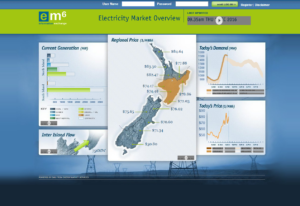
Program Background
As System Operator, Transpower is responsible for real-time security and scheduling and dispatch of the power system 24 hours a day, 7 days a week. A key input into undertaking this role is accurate load forecasting over the medium term horizon (30 minutes to 14 days). This is known as the Medium Term Load Forecast or MTLF.
There is an expectation that increasing distributed generation and demand response will make forecasting more challenging. Transpower has also developed and trialled its Demand Response programme for transmission deferral. Effective and economic use of Demand Response for this purpose also requires an accurate load forecast.
For these reasons, Transpower sought to explore what is possible in terms of improving its MTLF accuracy, and in 2011 embarked on a project to ascertain the quantum and economics of possible improvements to its existing MTLF model.
In 2012 Transpower held a trial to identify a better load forecast than its existing one. Participants in the trial were selected through a competitive tender. Of the 14 companies that responded to Transpower’s initial approach to the market, Transpower selected five companies to take part as participants in the trial. Selection was based on responses to technical and commercial load forecast requirements, as well as each respondent’s experience in load forecasting for utilities. Transpower’s own MTLF model was included as a ‘sixth participant’ in the trial.
Following the trial, TESLA Asia Pacific Ltd (TESLA) was selected as the preferred vendor, on the basis of its demonstrated performance in the trial, assessment against Transpower’s functional and non-functional requirements, and costbenefit analysis.
In 2016, Energy Market Services (a commercial business group within Transpower NZ Ltd.) entered into a joint venture with TESLA to supply TESLA forecasts on a subscription basis to our market participants.
This version of the report has been prepared to document the performance of the selected preferred vendor TESLA. It has been modified to remove all cost and pricing information, and to protect the identity of other participants.
Program Benefits
Richard Rowell, Manager EMS, said that making the load forecast service available to market participants will produce a number of benefits across the industry.
“We previously conducted a benchmark exercise with a number of participants, which found the new load forecasting service could reduce load uncertainty by as much as 70%. The TESLA load forecast service was found to be the most accurate and reliable,” he said.
“Customers of the service will be able to benefit through smart use of the forecast, for example through improved bidding strategies and by scheduling load away from likely peak periods,” he said.
“The electricity market is strengthened when better information is available, so we expect this service will enable efficiencies for our customers. We would expect to see cost reductions from improvements in plant commitment between $3.3 million and $5.8 million for the 2016-2020 period.
“In the long term, we believe adopting this tool could lead to lower overall wholesale purchase costs from improved demand response, which would benefit for all New Zealanders."